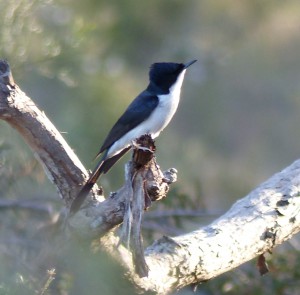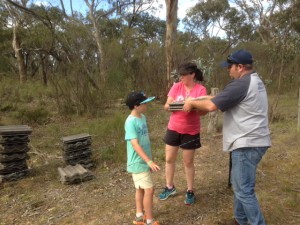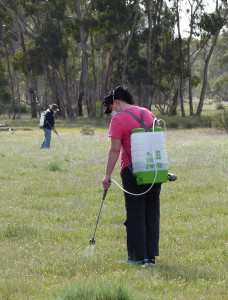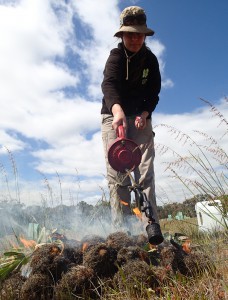Summing up the 1st Eaglehawk Working Bee and Campout
The first Eaglehawk Waterhole working bee was held this week, with a great turn out of volunteers helping with a range of tasks and enjoying the peaceful surroundings of the Bangham area. Ten people made the campout a great success from Sunday 28th September to Wednesday 1st of October. This outing also forms part of the Regionally Under-represented Ecological Communities project and it combined forces with Cassie Hlava’s Landscape Links project (DEWNR) to expose volunteers to a range of regeneration techniques, land management and habitat survey activities.
Sunday was filled with setting up camp and exploring the boundaries of the property, which revealed the extent of the natural regeneration occurring, along with reviewing weed outbreaks and vermin issues. It was anticipated that rabbit numbers would be high, however very few were observed (<15) on the first nights spotlighting, a very pleasing initial result. Only one fox was observed during the entire 4 days.
Insect surveys were undertaken during the day and night with a UV light trap set up in Stringybark habitat to attract a diversity of nocturnal insects. This was a perfect activity for kids and the resulting critters were sorted the following morning. An encouraging number were seen (>30 species) including wasps (1), beetles (4+), moths (20+), lace wings (1), cockroach (1), flies/mosquitoes (2-3) and spiders (2). Day flying insects were in short supply however it’s anticipated that the season will improve the closer we get to summer. In all we saw: butterflies (7) including the migratory Caper white, and dragonflies (2). Other insects were observed but not touched and grids of 50 roofing tiles were placed out for ants in three sites.
Seed collecting was undertaken for a range of species like Melaleuca uncinata (Broombush), Callitris gracilis (Slender Pine), Leptospermum continentale (Prickly Tea-tree), Banksia ornata (Desert Banksia), Elymus scabra (Common Wheat grass), and Callistemon rugulosus (Scarlet Bottlebrush). The intent is for NGT to collect as many species as possible and undertake re-establishment throughout the property as time and resources permit. A further outing is scheduled for December to collect other species – particularly wattles when seed becomes available in early summer.
As Eaglehawk was a farming property for many years, the task of controlling pasture weeds will be a long term one. However after some time spent on mapping in the last 12 months we began the control of Salvation Jane, Phalaris and Golden-wreath Wattle. Our October and November outings will also focus on some further weed control.
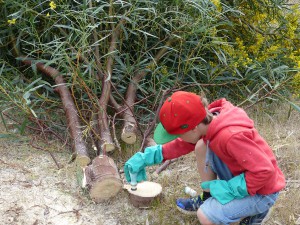
Cut and swab of Golden Wreath Wattle (Acacia saligna), a WA species not welcome in the South East of SA
There is a long history of wood cutting and/or harvesting throughout Eaglehawk Waterhole. We have now found four large piles of sawn timber which could be utilised for building recreation facilities, signs or track demarcation posts. During our stay we began the process of sorting through a pile to determine pieces that could be suitable for such purposes.
A visit to the bush could not be complete without the camera to capture the wildflowers. Several ramble surveys were undertaken in two habitats to further document the interesting flora for the site with several new species (to Eaglehawk) observed. We found a small pocket of Common Wheat grass (Elymus scabra), a large population of Beard-orchid (Calochilus robertsonii), many Sun-orchid leaves and buds, several species of Sun-dews (Drosera) and two species of Heath-myrtle (Calytrix).
During the trip we assisted the Landscape Links project officer Cassie Hlava from Natural Resources SE with prickly tea-tree matting establishment, burning of Banksia ornata cones to promote seed dispersal and germination, and set up a roofing tile grid for monitoring of fauna within the revegetation area.
And lastly – but not least – were the birds, mammals and reptiles. We had more stumpy lizards than you could poke a stick at! The echidna’s were patrolling around at a quick pace, and the restless flycatchers and white-bellied cuckoo-shrikes around the campsite was just fabulous. Peaceful doves drinking from the dam and Red-tails roosting in dense Blue gums were a real treat.
All in all it was an eventful and productive trip.
If you are interested in coming along to a future working bee, to get involved and see the wildlife for yourself, please get in touch.


